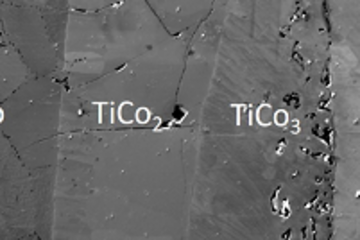All genres
1.
Journal Article
The role of Laves phase on microstructure evolution and creep strength of novel 9%Cr heat resistant steels. Intermetallics 32, pp. 362 - 372 (2013)
2.
Journal Article
Determination of phase equilibria in the Fe–Mg–Si system. International Journal of Materials Research 102 (8), pp. 1042 - 1047 (2011)
3.
Journal Article
Design and Characterization of microstructure evolution during creep of 12%Cr heat resistant steels. Materials Science and Engineering A 527, pp. 3864 - 3876 (2010)
4.
Journal Article
Phase equilibria in the Fe–Al–Mo system - Part II: Isothermal sections at 1000 and 1150 °C. Intermetallics 16 (6), pp. 834 - 846 (2008)
5.
Journal Article
Experimental reinvestigation of the Co–Nb phase diagram. Intermetallics 16 (6), pp. 785 - 792 (2008)
6.
Journal Article
Phase equilibria in the Fe–Al–Mo system - Part I: Stability of the Laves phase Fe2Mo and isothermal section at 800 °C. Intermetallics 16 (5), pp. 706 - 716 (2008)
7.
Journal Article
Study of cavity evolution during creep by synchrotron microtomography using a volume correlation method. Praktische Metallographie/Practical Metllography 45 (5), pp. 242 - 245 (2008)
8.
Journal Article
In-situ 3D Quantification of the Evolution of Creep Cavity Size, Shape and Spatial Orientation using Synchrotron X-ray Tomography. Materials Science and Engineering A 478, pp. 108 - 118 (2008)
9.
Journal Article
In-situ tomographic investigation of brass during high-temperature creep. Scripta Materialia 59 (5), pp. 558 - 561 (2008)
10.
Journal Article
Visualisierung der Kriechschädigung in Messing durch Tomographie mit Synchrotronstrahlung. Metall 61, p. 742 - 742 (2007)
11.
Journal Article
Microstructure and mechanical properties of Fe3Al-based alloys with strengthening boride precipitates. Intermetallics 15, pp. 1172 - 1182 (2007)
12.
Journal Article
Re-evaluation of phase equilibria in the Al–Mo system. International Journal of Materials Research 97 (11), pp. 1502 - 1511 (2006)
13.
Journal Article
Mechanical properties of Fe–Al–M–C (M=Ti,V,Nb,Ta) alloys with strengthening carbides and Laves phase. Intermetallics 13 (12), pp. 1256 - 1262 (2005)
14.
Journal Article
Microstructure and mechanical properties of Fe3Al-based Fe–Al–C alloys. Intermetallics 13 (12), pp. 1322 - 1331 (2005)
15.
Journal Article
The strengthening effect of (Ni, Fe)Al precipitates on the mechanical properties at high temperatures of ferritic Fe–Al–Ni–Cr alloys. Intermetallics 13 (12), pp. 1263 - 1268 (2005)
16.
Journal Article
Mechanical Properties and Oxidation Behaviour of Two-Phase Iron Aluminium Alloys with Zr(Fe,Al)2 Laves Phase or Zr(Fe,Al)12 τ1 Phase. Intermetallics 13 (12), pp. 1275 - 1285 (2005)
17.
Journal Article
Structure and stability of Laves phases. Part II: Structure type variations in binary and ternary systems. Intermetallics 13 (10), pp. 1056 - 1074 (2005)
18.
Journal Article
Plastic deformation of Fe–Al polycrystals strengthened with Zr-containing Laves phases: Part II. Mechanical properties. Materials Science and Engineering A: Structural Materials Properties Microstructure and Processing 381 (1-2), pp. 1 - 15 (2004)
19.
Journal Article
Plastic Deformation of Fe–Al Polycrystals Strengthened with Zr-Containing Laves Phases: I. Microstructure of Undeformed Materials. Materials Science and Engineering A: Structural Materials Properties Microstructure and Processing 380 (1-2), pp. 9 - 19 (2004)
20.
Journal Article
Structure and stability of Laves phases. Part I - Critical assessment of factors controlling Laves phase stability. Intermetallics 12 (7-9), pp. 713 - 720 (2004)











